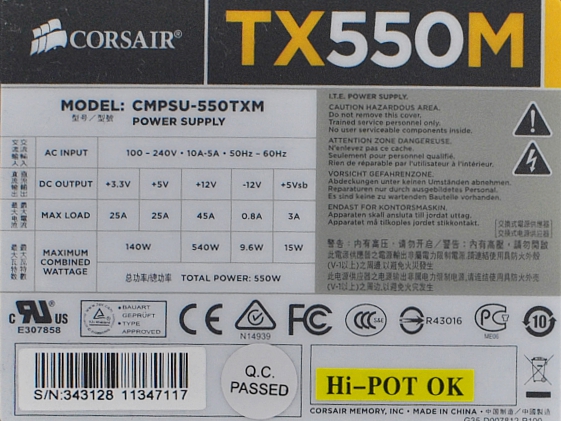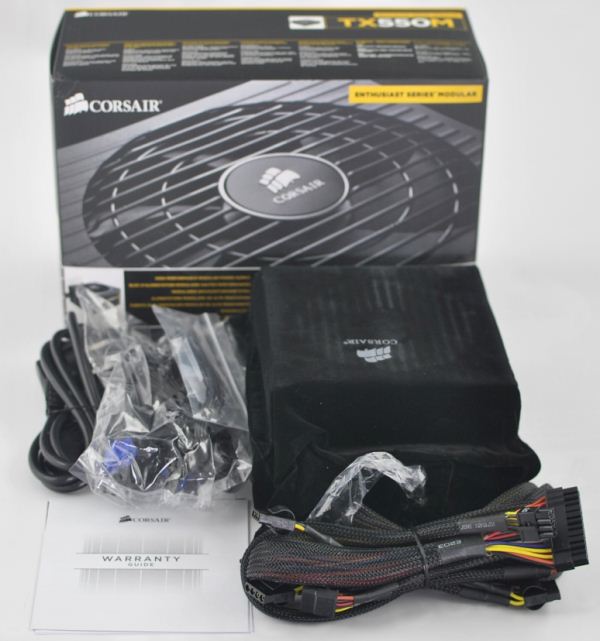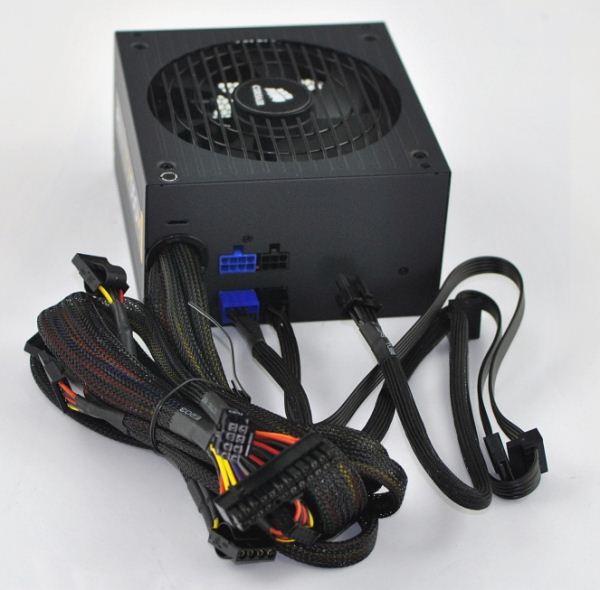Corsair TX vs. OCZ ZT 550W
by Martin Kaffei on March 26, 2012 9:30 AM EST- Posted in
- Cases/Cooling/PSUs
- Corsair
- PSUs
- OCZ
- 550W
- 80Plus Bronze
- ZT
- TX
Corsair TX550M Overview
In the package we find a large number of modular cables in a plastic packaging, an accompanying document with warranty agreements, one Corsair sticker (for your case), some cable ties, four screws, and one power cord. In short, Corsair provides plenty of extras to keep the customers satisfied.

Corsair believes in powerful single rails. On +12V this PSU can deliver nearly the full power since step-down-converters are included for the smaller rails. +3.3V as well as +5V are rated at 140W and/or 25A maximum load. At 3A, 5VSB is relatively powerful as well.
The PSU has a black finish and honeycombed ventilation holes. There is no typical fan grill but a solution be quiet! (Listan) used before. At 160mm, the case is moderately long. As usual these days, there is a power switch next to the mains plug. Modular cables can be mounted on the connector panel at the rear side, and as usual Corsair's overall build quality is very good.
| Cables and Connectors | ||
|
Connector type (length) |
Main | 1x 24-pin (60cm) fixed |
| ATX12V/EPS12V | 1x 4+4-pin (60cm) fixed | |
| PCIe |
1x 6/8-pin (60cm) modular 1x 6/8-pin (60cm) modular |
|
| Peripheral |
3x SATA (ca. 40, 55, 70cm) fixed 3x SATA (ca. 40, 55, 70cm) modular |
|
|
3x Molex (ca. 40, 55, 70cm) fixed 3x Molex (ca. 40, 55, 70cm) modular 2x FDD adapter (ca. 10cm) modular |
||
The 24-pin cable is relatively long with 60cm. The long CPU cable is very good as well, particularly for cases where the PSU is mounted on the bottom. The 24-pin, the CPU, and two peripheral cables are fixed. Note that there are FDD adapters. Corsair included the adapters in the packaging, though, "just in case". Moreover all removable cables consist of black wires only. Some of them are flat as well.



















41 Comments
View All Comments
Stuka87 - Monday, March 26, 2012 - link
On the last page where things are being highlighted, shouldn't the Corsair be highlighted for efficiency and ripple since it was ahead in these categories? Unless the yellow is just meant to show there is a difference. But it seams in the rest of the areas the better supply is highlighted.Both supplies look pretty good though, even if priced a bit higher than some similar supplies.
Martin Kaffei - Monday, March 26, 2012 - link
Sounds more correct, right.Thanks a lot.
lyeoh - Monday, March 26, 2012 - link
Has Corsair really improved their quality since: http://www.behardware.com/articles/843-3/component...FWIW, OCZ and Corsair's nonPSU stuff seem to get returned quite often too:
http://www.behardware.com/articles/843-4/component...
http://www.behardware.com/articles/843-7/component...
http://www.behardware.com/articles/843-8/component...
Both these PSUs might be OK, but why should I care? There are other manufacturers who have a better track record when it comes to quality. Poor quality in a range of similar models is understandable, but poor quality in different types/classes of products just tells me to avoid buying anything from them.
I'd prefer to see more reviews of products from manufacturers that care about quality. Who the heck wants to read reviews of food from restaurants that have a long track record of giving a significant percentage of their customers food poisoning? I don't care how good their food looks.
Are these even significantly cheaper?
Samus - Tuesday, March 27, 2012 - link
My advice to you is stop reading BEHardware.Those statistics for every segment they 'measured' are a joke. Just drafting such a distasteful article is a huge lapse in journalism judgement on their part. Nobody in their right mind would gauge component reliability based on return rates over a 6-month period from a single source.
The only way to measure reliability is by reviewing the initial quality in detail and putting the components into real-world scenarios to report any abnormalities over time. AnandTech and other legitimate hardware review sites do this, as does Car & Driver, Consumer Reports, Home Theater Review, Gun Directory, etc
seanleeforever - Tuesday, March 27, 2012 - link
while i agree with your point of view, but AnandTech rarely review abnormalities over time. and bear in mind AnandTech is more akin to C&D not CR because AnandTech receives cherry picked product directly from manufactures. and you really have to hope what you buy from your local frys is the same as the one they choose to send for reviewing.lyeoh - Thursday, March 29, 2012 - link
6 month period? OCZ's poor track record goes way back longer than that: http://www.behardware.com/articles/831-7/component...http://www.behardware.com/articles/831-4/component...
http://www.behardware.com/articles/810-6/component...
http://www.behardware.com/articles/810-4/component...
You haven't even provided a good reason why anyone should care about your opinion on this subject especially since you said "6 month period".
I'd believe BeHardware's article more than I'd believe you, especially since a few simple Google searches for product problems do not disagree with their statistics. So it's not just a freak incident where only the french retailer has higher rate of returns for OCZ and corsair stuff.
fausto412 - Monday, March 26, 2012 - link
I have a 6990 and a n AX850 PSU...that psu gets super hot when gaming. Can't imagine a 550 watt psu not melting. I think the days of the 550 watt psu are over unless you only do single card gaming and don't use the highest end cards.Ken g6 - Monday, March 26, 2012 - link
Did you miss the GTX 680 review the other day? http://www.anandtech.com/show/5699/nvidia-geforce-... The 7970 would work fine with a 550W PSU too.Also recall that the 6990 is effectively two cards in crossfire on a single board.
Samus - Tuesday, March 27, 2012 - link
I run a GTX570, Core i7-950, 12GB RAM, 5 hard drives and some other shit off a PCP&C 500-watt PSU. Whole system is reasonably warm after hours of gaming and is completely stable.Kill-A-Watt has never reported more than 400-watts drawn from the wall, so my 500-watt PSU never even hits 80% load.
Any never system with a single GPU draws less power, I guarantee it. 550-watt is overkill for most people with current technology. Remember most OEM systems still ship with 250-watt PSU's.
Stuka87 - Monday, March 26, 2012 - link
I use a Antec NEO-ECO 520C with my over clocked 7950 and its perfectly fine. I never get anywhere close to even 400W at peak (And thats with a 4.1GHz Phenom II) when measured at the wall. The latest chips from AMD and nVidia are incredibly efficient. The 6990 is a pretty big power hog comparatively, and it is a dual GPU card.